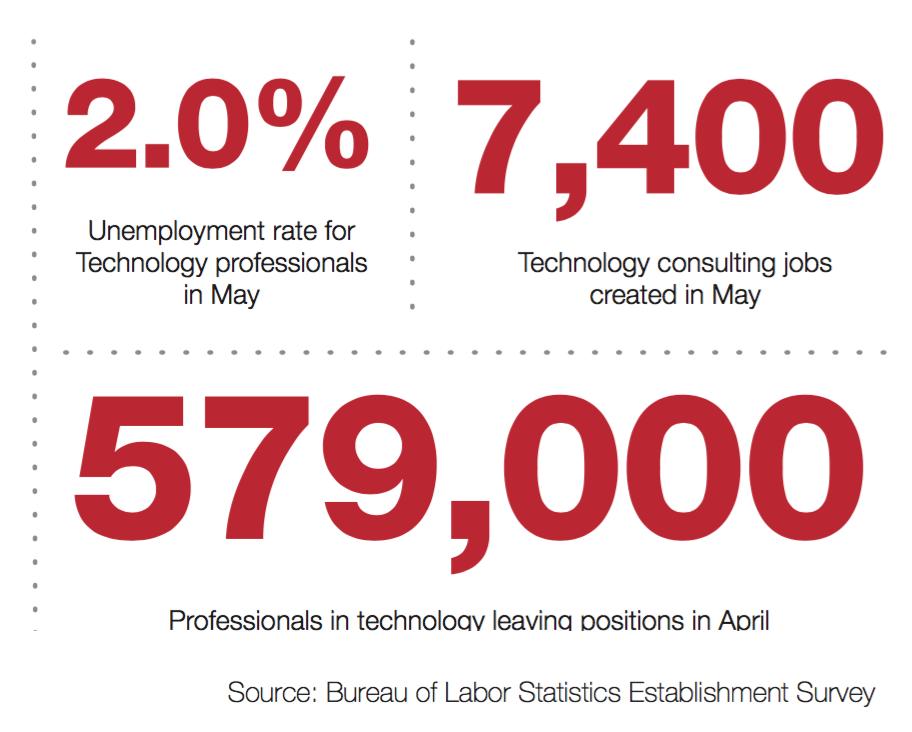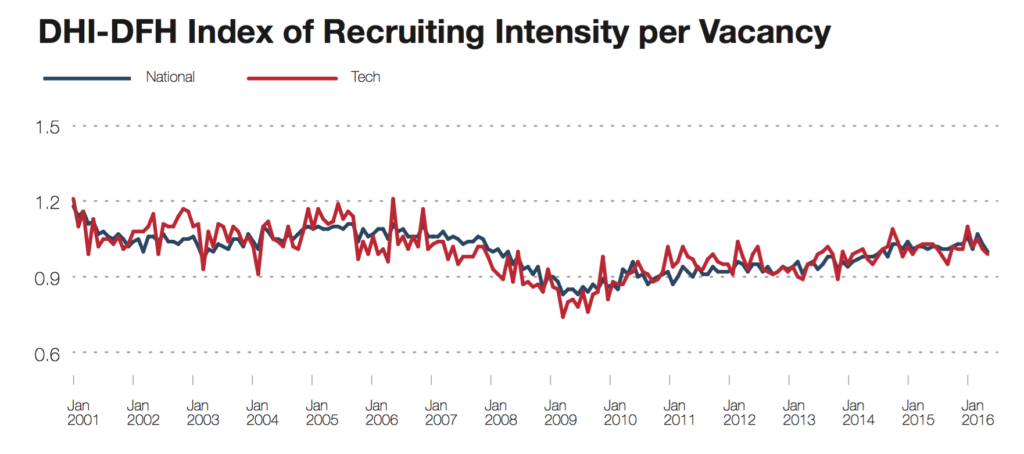
The DHI-DFH Mean Vacancy Duration measure found the average job vacancy duration of Professional and Business Services jobs to be 25.8 working days in 2016. In April, technology jobs remained open for 24.8 working days,
down from a revised 27.3 days in
March. “When we recently asked a number of DHI customers, the majority of hiring managers told us they intend to hire more professionals and the current economic environment has had no impact on hiring plans for the remainder of the year,” said Michael Durney, President and CEO of DHI Group. “Still, recruiting continues to be a struggle. The inability to find qualified candidates along with employers waiting to find the perfect combination of specific skills to fill an open role has lengthened hiring times relative to last year.”

Meanwhile, the DHI-DFH Recruiting
Intensity index saw the intensity of
companies to fill tech jobs dip to 0.99 in April from 1.01 in March. This recruiting intensity includes actions by employers to fill a job, including payments on help wanted ads, certain recruiting methods, applicant screening process, hiring standards and the attractiveness of compensation packages offered to prospective new hires. “Nearly half of tech-focused employers told us the time to hire tech professionals has lengthened relative to last year in a recent Dice survey,” said Bob Melk, President of Dice. “When asked, 40 percent of clients said
they intend to hire up to 20 percent more professionals in the second half of this year. But this won’t be easy as many say there are positions they are unable to fill due to salary requirements, which also lengthens the hiring process.”

About
The DHI Hiring Indicators offer labor market insights from career provider
DHI Group, Inc. and
Dr. Steven Davis, William H. Abbott Professor of International Business and Economics at the University Of Chicago Booth School Of Business and a Visiting Fellow at the Hoover Institution. The DHI-DFH vacancy duration measure reflects the vacancy concept in the Job Openings and Labor Turnover Survey (JOLTS) in the United States. Specifically, a job opening gets “filled” according to JOLTS when a job offer for the open position is accepted. So the vacancy duration statistics refer to the average length of time required to fill open positions. Typically, there is also a lag between the fill date and the new hire’s start date on the new job. The Indicators include a monthly report and data release to help employers, professionals and decision makers deepen their understanding of current workforce trends. The category of Professional and Business Services includes professional, scientific and technical activities for others. The category of Computer Systems Design and Related Services rolls into this.

 The DHI-DFH Mean Vacancy Duration measure found the average job vacancy duration of Professional and Business Services jobs to be 25.8 working days in 2016. In April, technology jobs remained open for 24.8 working days,
down from a revised 27.3 days in
March. “When we recently asked a number of DHI customers, the majority of hiring managers told us they intend to hire more professionals and the current economic environment has had no impact on hiring plans for the remainder of the year,” said Michael Durney, President and CEO of DHI Group. “Still, recruiting continues to be a struggle. The inability to find qualified candidates along with employers waiting to find the perfect combination of specific skills to fill an open role has lengthened hiring times relative to last year.”
The DHI-DFH Mean Vacancy Duration measure found the average job vacancy duration of Professional and Business Services jobs to be 25.8 working days in 2016. In April, technology jobs remained open for 24.8 working days,
down from a revised 27.3 days in
March. “When we recently asked a number of DHI customers, the majority of hiring managers told us they intend to hire more professionals and the current economic environment has had no impact on hiring plans for the remainder of the year,” said Michael Durney, President and CEO of DHI Group. “Still, recruiting continues to be a struggle. The inability to find qualified candidates along with employers waiting to find the perfect combination of specific skills to fill an open role has lengthened hiring times relative to last year.”  Meanwhile, the DHI-DFH Recruiting
Intensity index saw the intensity of
companies to fill tech jobs dip to 0.99 in April from 1.01 in March. This recruiting intensity includes actions by employers to fill a job, including payments on help wanted ads, certain recruiting methods, applicant screening process, hiring standards and the attractiveness of compensation packages offered to prospective new hires. “Nearly half of tech-focused employers told us the time to hire tech professionals has lengthened relative to last year in a recent Dice survey,” said Bob Melk, President of Dice. “When asked, 40 percent of clients said
they intend to hire up to 20 percent more professionals in the second half of this year. But this won’t be easy as many say there are positions they are unable to fill due to salary requirements, which also lengthens the hiring process.”
Meanwhile, the DHI-DFH Recruiting
Intensity index saw the intensity of
companies to fill tech jobs dip to 0.99 in April from 1.01 in March. This recruiting intensity includes actions by employers to fill a job, including payments on help wanted ads, certain recruiting methods, applicant screening process, hiring standards and the attractiveness of compensation packages offered to prospective new hires. “Nearly half of tech-focused employers told us the time to hire tech professionals has lengthened relative to last year in a recent Dice survey,” said Bob Melk, President of Dice. “When asked, 40 percent of clients said
they intend to hire up to 20 percent more professionals in the second half of this year. But this won’t be easy as many say there are positions they are unable to fill due to salary requirements, which also lengthens the hiring process.” 


